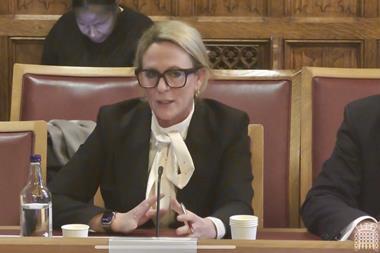No one seems to be able to agree on where liability rates are headed. Our panel of experts in Manchester discusses the situation
Round table
The panelPauline Quayle, ChartwellSteve Duffy, Sterling Hamilton WrightKeiran Jones, WeightmansGraham Smart, GAB RobinsMark Walker, Royal & SunAllianceKay Meredith, Priestley & PartnersAndy Cook/B>, Insurance TimesAndy Cook: The British Chamber of Commerce last week said liability rates for its members were still advancing at ten times inflation. Insurers say rates are stable but brokers say they are falling. What is your experience?Pauline Quayle: Well it's fair to say that the motor market is definitely softer than it was. I understand there's more capacity, which has had some direct impact. Material damage is also softer than it was - it's softening, but not to the same extent as motor insurance. Liability, certainly from an employers' liability (EL) point of view, we're seeing it stable, but nothing silly. One of the questions that came into my mind was just where insurers are really going. Are they going down the route of market share, which always brings the softening problem? I actually shed tears with clients and for them. Where does it leave us, because we're now going backwards. Instead of having some stability, we're just back into the slide. I don't see it's going to be any better. I think it's going to go softer again.The composite market's as guilty as anyone. The latest buzz words are red, green and amber and all of that. Every insurer I can think of seems to have red trades and green trades, and "let us put your profile of your prospects on our matrix and let's see what we can do". But the reality is, let's just get back to some realistic underwriting for some good quality risks, and for not-so-good quality risks at realistic rates.Steve Duffy: As a Lloyd's broker, I've a slightly different perception from Pauline. From the motor point of view, we do have a large motor portfolio. Our figures are showing that geographically there's more softening in certain areas than other areas. The fleet market, which Lloyd's still has a strong presence in, we're holding our own on haulage, self-drive hires and private cars against two or three composites that are under-cutting rates. Liability has definitely plateaued. There are two or three new markets that have come into the liability arena now. The rates are probably at a more realistic rate than they were four or five years ago. I don't think there can be much growth in the rates this year. Commercial combined is softening, particularly the small to medium sized enterprise (SME) market, because everyone seems to be after the SME type of business. In professional indemnity (PI), our portfolio increased by only about 6% this year - much of that's down to softening of rates. The schemes, the niche markets - they're staying stable, and will probably continue to stay stable on the niche type markets. One point I will pick up on that Pauline raised is the lack of quality underwriting in the marketplace. As a Lloyd's broker I would probably say, and no disrespect to Royal & SunAlliance, of course, that Lloyd's underwriting is quality underwriting because you've got experience in the Lloyd's market and you can apply rate to risk. Pauline made a point about the poorer risk. There's no such thing as a bad risk, there's only a bad rate. We had a client about two or three months ago that was with the composite market at a rate that went through the roof by about 80%. The risk came into the Lloyd's market and has gone back to the composite market at a rate less than what he originally had it.Kieran Jones: I come to this very much from the perspective of a lawyer on the liability side and from the disease side particularly. It is interesting to look at the issue of compensation culture as the driver for the rate cycle. The Arculus report suggests that claims compensation culture isn't there. The very fact that the Arculus report ever came about suggests that there was a concern about this so-called compensation culture. But there's a lot that's happened over the past 12 months on the road traffic side - you have these fixed fees, you have the 12% success fees, you don't have all those arguments that were going on, the satellite litigation that was going on up until recently, until they were settled, and you don't have all those arguments going on with regard to what is an appropriate success fee.So you're left with this 12% on the base costs up to the 100% if the matter proceeds to trial. Slightly different on the EL side, you havethe 25% as the base success fee. So they should bring some certainty to the market, they should bring some more predictability to the level of cost, one would hope, that ultimately would be factored into the sorts of premiums that your clients will be paying.Going forward, the Arculus report is quite specific in the guidelines that it has given with regard to claims farming companies. A couple of the recommendations are good - the recommendation that they're not allowed to advertise in hospitals any more, they're not allowed to advertise in GPs' surgeries. At the moment it doesn't have teeth, but they are going back to that industry and saying "Look, you regulate yourselves otherwise we farm it over to the Department of Constitutional Affairs."It would appear that there should be some more certainty in terms of the cost element particularly. I don't think the damages issue has ever been a particular problem. Lawyers, loss adjusters or claims handlers have been able to assess the level of damages with a reasonably degree of certainty.Graham Smart: Where are we in the cycle? From our perspective I would say we see both aspects. Undoubtedly, there's more capacity in the market. That's being evidenced by some of the newer players, particularly in the SME market. There seem to be two or three players really looking for market share and starting to build relationships. But the converse of that is there's still a great desire among the bigger companies to self-fulfill, moving away from traditional insurance arrangements, and taking higher deductibles. That is an increasing trend.I read on the train today a couple of examples of school fetes, garden parties and community events that just can't get cover. But capacity seems to be coming back. I can't speak about rates, because that's not a sphere that we're involved in, but there certainly does seem to be a wider range of covers available.AC: Are you finding that the self-insurance market is still increasing? GS: I would say the appetite has almost reached fulfillment. I don't see that coming right back down into the SME market. It's more the bigger corporate players, but there still seems to be an extension of the levels of self-insurance that they're prepared to accept. That's now spreading across more global programmes.Claims incidence is undoubtedly down, for a whole host of reasons, but certainly the claims incidence at the higher level has dropped dramatically. That's reflective of better risk management. Local authorities, for example, have got a better grip on risk management than they've ever had. Five years ago there would be a glut of school fires during the summer holidays. That no longer seems to be the case because the buildings have gone back in a more modular form, with more fire-retardant construction. There are probably fewer of them about as well. The insurance consumer at that level has assumed the risk and done a pretty good job of mitigating the risk. As Pauline says, having done that, you have a greater acceptance or greater desire to accept higher and higher risk because you know you're in a better position to control it.Mark Walker: We all want the same thing, which is more consistency, being able to manage risk as opposed to crisis manage. You guys don't want to crisis manage your clients, clients don't want to crisis manage the business, and we certainly don't want to crisis manage our rated portfolios. It's easy for customers to turn around to brokers and say: "What are you doing about it?" The brokers ten turn around to insurers and say: "What are you doing about it?" When do we ever stop and ask: "Who started this?" We mention this cycle, it's almost as if we enjoy it, it's a way of demonstrating our expertise in certain times. It's almost a self-fulfilling prophecy that we're always going to have a cycle.The wholesalers in London drive a lot of the premium savings, so I know some of the analysis that those guys are looking at. On the property risk they're looking at anything up to 20% savings. We haven't seen that because that's the wholesaling market, and we're not seeing that coming through the UK retail market.We acknowledge there are some over-priced risks out there, and that's what we'll do something about.PQ: There are certain brokers that we've seen at the beginning of the year writing to clients of ours and other people, saying: "We can cut your rates by 20%". Now, if I was an insurer I'd be pretty cross about that and I'd be saying: "That is so irresponsible, why are we dealing with you?" But insurers don't confront this.MW: In old money, anything up to £1m turnover would be deemed as SME, which would equate to £2,500 to £5,000 premium spend. We're now seeing people who spend up to six figures buying on what is almost a commodity basis.Kay Meredith: A hard and soft market doesn't do any good at all for relationships because it does leave you vulnerable as a broker. If a client hears that their friend has had a quote of £5,000 less, it's going to have an effect. It's up to us to have the consistency and know that we're with the right insurer and support their premium level. We want what's best for the client. However, the client might sometimes want what's best for their pocket. So unless you have a long-established client and a great relationship with them, you're going to find that at times the premium level does come into it.Things are changing, but not substantially. Then there are the rogue insurers. You hear talk about rogues everywhere, but you will always be in a situation where you might prefer to be in a traditional market.You might find that another broker has just sent a circular saying: "Come and have a look at us". The broker may then quote somebody that you wouldn't want to place business with.
Hosted by comedian and actor Tom Allen, 34 Gold, 23 Silver and 22 Bronze awards were handed out across an amazing 34 categories recognising brilliance and innovation right across the breadth of UK general insurance.













































